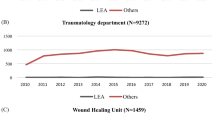Abstract
We studied prospectively 87 patients who underwent extremity amputation in the National Orthopaedic Hospital in Lagos in 1995–1996. Trauma from road traffic accident was the most common indication (34/87) with peripheral vascular disease being the least encountered (2/87). Traditional bonesetters' gangrene accounted for 9/87 cases in circumstances that were largely avoidable. Our study revealed that amputation is still being performed as a life-saving procedure, as 44/87 patients presented with gangrene of a limb. The nonavailability of special investigations such as Doppler ultrasound, arteriography, and CT scan was responsible for a delay in definitive treatment in 28 cases. Poor prosthetic services and the absence of a well-coordinated amputee clinic were responsible for some of the unsatisfactory results. We believe that the availability of specialized diagnostic tools and facilities for microvascular surgery, together with a multidisciplinary approach to the management of the amputee, would considerably change the current gloomy picture of amputation in developing countries such as Nigeria.
Résumé
Nous avons étudié prospéctivement 87 malades qui ont subi une amputation de l'extrémité d'un membre dans l'Hôpital Orthopédique National de Lagos en 1995/96. Les traumatismes résultant d'accident de la route, était l'indication la plus commune (34/87) tandis que les maladies vasculaires périphériques étaient la plus rare (2/87). La gangrène causée par la fixation traditionnelle des fractures a expliqué 9/87 cas dans circonstances qui étaient en grande partie évitables. Notre étude a révélé que l'amputation était encore exécutée comme une procédure de sauvetage chez 44 /87 malades présentant une extrémité gangrèneuse. La non—disponibilité d'outils d'investigation spécialisés comme le doppler, l' artériographie et le scanner était responsable d'un retard dans le traitement définitif dans 28 cas. L'insuffisance des possibilités d'appareillage et l'absence d'une clinique de l'amputé bien coordonnée sont des éléments nuisibles mis en évidence par cette étude. Nous croyons que la possession d'outils diagnostiques spécialisés et des installations. Pour chirurgie microvasculaire, dans le cadre d'une approche multidisciplinaire de la gestion de l'amputé changerait considérablement l'image sombre de l'amputation dans un pays en voie de développement comme le Nigeria.


Similar content being viewed by others
References
Anyanwu SNC (1994) The diabetic foot: A major surgical problem in our environment. Nig J Surg 1(1):26–28
Garba ES, Deshi PJ (1998) Traditional bone setting: a risk factor in limb amputation. East Afr Med J 75:553–555
Gregory–Dean A (1991) Amputations: statistics and trends. Ann R Col Surg Engl 73:137–142
Jamieson MG, Ruckley CV (1983) Amputation for peripheral vascular disease in a general surgical unit. J R Coll Surg Edinb 28:46–50
Katchy AU, Chukwu COO, Nwankwo OE, Onabowale BO (1997) Lower limb amputation in a specialist hospital: review of 120 patients. Orient J Med 9:27–29
Muyembe VM, Muhinga MN (1999) Major limb amputation at a provincial general hospital in Kenya. East Afr Med J 76:163–166
Naaeder SB (1993) Amputation of the lower limb in Korle–Bu Teaching Hospital, Accra. West Afr J Med 12:21–26
Onabowale BO, Onuminya JE, Essien IAJ, Ukegbu ND (1995) The management of open tibial shaft fractures: The National Orthopaedic Hospital experience. Nig J Surg 2:37–41
Onuba O, Udoidiok E (1989) The scope of amputation in developing countries. Postgrad Dr Africa 11(5):118–121
Osisioma ECO, Onuminya JE (1992) Diabetic foot gangrene. Nig J Surg Sci 2:62–66
Tooms RE (1987) General principles of amputations. In: Crenshaw AH (ed) Campbell's operative orthopaedics. Mosby, USA, pp 597–606
Acknowledgment
We wish to thank the consultant surgeons of the NOHL whose patients were included in this study.
Author information
Authors and Affiliations
Corresponding author
Rights and permissions
About this article
Cite this article
Yinusa, W., Ugbeye, M.E. Problems of amputation surgery in a developing country. International Orthopaedics (SICOT) 27, 121–124 (2003). https://doi.org/10.1007/s00264-002-0421-x
Accepted:
Published:
Issue Date:
DOI: https://doi.org/10.1007/s00264-002-0421-x




